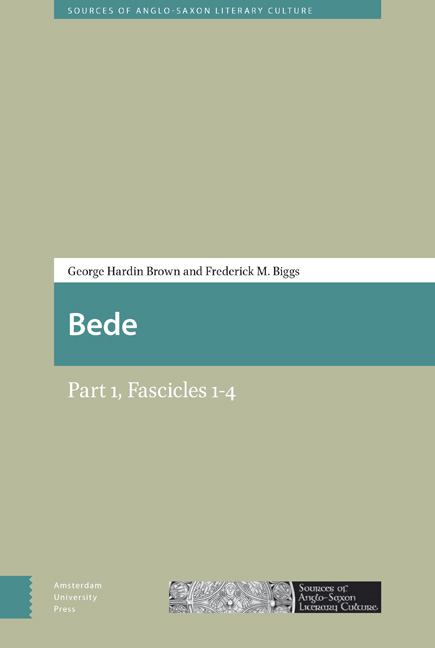Histories
Published online by Cambridge University Press: 02 February 2021
Summary
“Bede was in many ways a natural historian”: so Alan Thacker begins his “Bede and History” in the Cambridge Companion to Bede (2010 p 170). An explanation of how he became a writer of histories, however, underlies our grouping of the HISTORIA ABBATUMand the HISTORIA ECCLESIASTICA GENTIS ANGLORUMin this section. The earliest work by Bede that we can date with certainty, DE TEMPORIBUS(703), ends with the so-called Chronica minora (chapters 17-22), a record of the main events in each of the six ages of the world. While this chronicle sometimes circulated separately, its author embedded it into a larger argument. As Calvin B. Kendall and Faith Wallis point out in the introduction to their translation of De temporibus (2010 p 6), it is “not without significance” that Bede was writing his COMMENTARIUS IN APOCALYPSIMat about the same time: both offer “a vigorous challenge to a chronology of world history that encouraged belief in the imminence of the Last Judgement.” Bede's other BIBLICAL COMMENTARIESalso provided ample opportunity to consider the progress of history, but they did not prompt their author to write a history of his own. Similarly, the earliest (probably) of his SAINTS’ LIVES, the metrical VITA CUTHBERTI, written in 705 or shortly thereafter, was intended to accompany the already existing anonymous VITA CUTHBERTI(see ACTA SANCTORUM). Its purpose was less to tell the events of Cuthbert's life than to encourage spiritual reflection on them, a feature common to the genre. Even Bede's innovation in his MARTYROLOGY, to combine chronicle and hagiography by including brief accounts of each saint's life and death, stops short of constructing a sustained historical narrative.
Bede's first history, the Historia abbatum, developed, we would suggest, out of the crisis of 716, when CEOLFRITH, abbot of Monkwearmouth- Jarrow, suddenly departed for Rome, where he planned to end his days. Although HWÆTBERTwas quickly elected to replace him, Bede's uncertainty about what the journey implied about the direction of the monastery would have increased when the community learned of Ceolfrith's death in Langres (in northeastern France) far from his destination. At a moment of some personal doubt Bede felt compelled to write a narrative that would affirm the history of his own monastery. “
- Type
- Chapter
- Information
- BedePart 1, Fascicles 1-4, pp. 123 - 206Publisher: Amsterdam University PressPrint publication year: 2017



